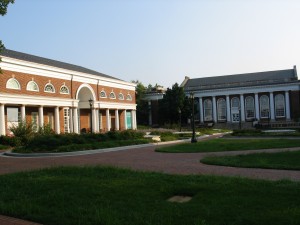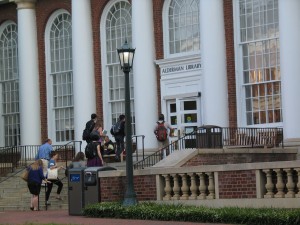Rare Book School Day 3
 Three sights have greeted me every morning so far: a rather imperial statue of the explorer George Rogers Clark (across the street from my hotel), the rising sun striking the face of special collections, and a line of librarians entering the Alderman Library when they open the doors at 8:00am (to the tune of chapel bells tolling the hour).
Three sights have greeted me every morning so far: a rather imperial statue of the explorer George Rogers Clark (across the street from my hotel), the rising sun striking the face of special collections, and a line of librarians entering the Alderman Library when they open the doors at 8:00am (to the tune of chapel bells tolling the hour).
We began the morning with an exercise. Each of us was given a 17thC book and told to examine it for form (i.e., what is there?) and function (i.e., what does it do?). Since I was not able to present my observations in class, because we often raise more questions than can be answered in the time allotted, I will do so here. My book was actually two works bound together (a sammelband) both published in 1630. Each imprint (which were duodecimos–gatherings of 12 leaves), was signed on the first five leaves of each gathering. However, within each imprint were multiple title-pages, which suggests that these were reprints of previously issued works, because the pagination was continuous throughout.
 The author of these tracts was Nicholas Byfield, a Calvinist who died rather horribly of a gall stone the size of a watermelon (15 x 13 inches) that weighed 3 lbs! The book is quite thick (about 4 inches), and just a little taller–with heavy leather over thick paper boards and the remnants of metal clasps–clearly a book intended to travel. On the back flyleaf was this inscription, or as much as I could make of it:
The author of these tracts was Nicholas Byfield, a Calvinist who died rather horribly of a gall stone the size of a watermelon (15 x 13 inches) that weighed 3 lbs! The book is quite thick (about 4 inches), and just a little taller–with heavy leather over thick paper boards and the remnants of metal clasps–clearly a book intended to travel. On the back flyleaf was this inscription, or as much as I could make of it:
“1735 Thomas Angell’s Book / God gave him grace therein to look and not but understand / for learning is better than house and land, [unclear] when house and land is spent / [unclear]” Clearly this was a book meant to keep the Christian on his path. There are many marginal notes in various hands, variously legible.
 After discussing the ways in which we can use the concept of format (which is the imposition scheme of a book; that is, the relationship of the text block of one printed page to the original sheet which was printed from the forme) to explain how books are put together, we then turned down the side road of discussing the pecia system of manuscript production during the rise of the universities; finally we dug more deeply into the uses and applications of the “workbook” that Michael has provided for our use. This includes many sample syllabi, exercises, diagrams, models, timelines, and tons of other resources to help us construct our own courses and instruction.
After discussing the ways in which we can use the concept of format (which is the imposition scheme of a book; that is, the relationship of the text block of one printed page to the original sheet which was printed from the forme) to explain how books are put together, we then turned down the side road of discussing the pecia system of manuscript production during the rise of the universities; finally we dug more deeply into the uses and applications of the “workbook” that Michael has provided for our use. This includes many sample syllabi, exercises, diagrams, models, timelines, and tons of other resources to help us construct our own courses and instruction.
As with the two times I have been here before (1999 and 2001), I know that I am making crucial contacts and significantly advancing my knowledge- and resource-base as a curator and for my work as a teacher of book history.